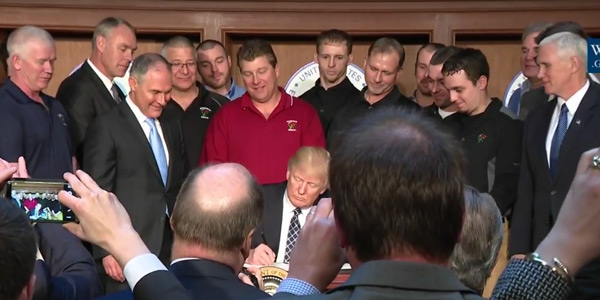The Trump administration’s replacement for the Clean Power Plan will require modest efficiency improvements that could boost the output of coal-fired generators while giving states discretion over enforcement, according to published reports.
The New York Times, The Washington Post, Politico and Bloomberg all reported that the replacement will be announced this week, perhaps at a Trump campaign rally in West Virginia coal country Tuesday. The Wall Street Journal reported Monday evening that acting EPA Administrator Andrew Wheeler had signed the new plan, which EPA has dubbed the “Affordable Clean Energy” (ACE) rule.
According to the reports, EPA has decided not to seek reversal of the 2009 finding that greenhouse gases endanger public health, as coal magnate Robert Murray and others have urged. Leaving the endangerment finding in place means the agency must address CO2 emissions. Wheeler is a former Murray Energy lobbyist.
The reports said EPA will order that individual coal plants make heat rate improvements to increase the electricity produced from the same amount of coal — reducing carbon emissions per megawatt-hour. Observers say that could increase coal plants’ dispatch as their lower production costs make them more competitive.
‘Inside the Fence Line’
The Obama administration’s plan would have required utilities to switch from coal to gas and renewables to produce a 32% cut in power sector carbon emissions below 2005 levels by 2030. The Trump administration says the CPP overstepped EPA’s authority by imposing regulations “beyond the fence line” of individual plants. (See EPA to Announce Clean Power Plan Repeal.)
The U.S. Supreme Court stayed the CPP pending legal challenges in February 2016. The D.C. Circuit Court of Appeals heard arguments in the case, but Trump’s EPA asked the court to delay its ruling so it could rewrite the rule. (See Analysis: No Knock Out Blow for Clean Power Plan Foes in Court Arguments.)
EPA previously estimated that “inside-the-fence-line” plant modifications, such as equipment upgrades and adoption of best practices, would improve average coal plant heat rates by 4%.
Politico reported that the White House Office of Management and Budget finished reviewing the draft and sent it back to EPA last week.
The plan reportedly would allow states to decide whether to adopt changes to “New Source Review,” a policy that requires power plants to adopt pollution controls when they make upgrades that could increase emissions.
The CPP replacement, following the proposed rollback of automobile efficiency standards, is another indication of the Trump administration’s determination to reverse Obama-era environmental policies and its reluctance to address climate change. EPA says transportation (26%) and electric generation (30%) are responsible for more than half of all greenhouse gas emissions in the U.S.
On Aug. 2, EPA and the National Highway Traffic Safety Administration announced they would cap fuel economy requirements at a fleet average of 37 mpg starting in 2020. Under the Obama rules, the standard had been set to rise to about 47 mpg by 2025.
Bloomberg noted that the release of the CPP replacement “comes during a summer dominated by wildfires and hotter-than-normal weather. Northern Europe has withered in a deadly heat wave. California recorded its hottest July on record as its forests burned on an unprecedented scale. At least 116 people in Japan have died this summer, with the country posting its highest-ever temperatures in July. Meanwhile, parts of India are dealing with the worst flooding in a century.”
Reduced Reductions
The Energy Information Administration says carbon emissions were 27% below 2005 levels at the end of 2017 and will drop another percentage point to 28% through 2030 without the CPP.
The Washington Post reported that the plan would allow the release of at least 12 times the amount of carbon dioxide into the atmosphere compared with the Obama rule over the next decade.
By 2030, the Post said, the new proposal would cut CO2 emissions from 2005 levels by 0.7 to 1.5%, compared with business-as-usual. The CPP would have cut carbon emissions by about 19% by the end of the next decade.
EPA’s new plan would reduce sulfur dioxide and nitrogen oxides that help form smog by 1 to 2% each from 2005 levels over the same time period. Cuts under the CPP for those pollutants would have been 24% and 22%, respectively, the Post said.
The new proposal, which is subject to a 60-day comment period, will almost certainly face legal challenges from environmentalists.
The Environmental Defense Fund said EPA should be more, not less, aggressive in reducing emissions despite industry trends favoring gas and renewable generation over coal.
“To be clear, we need the long-term regulatory signal established by the Clean Power Plan in order to ensure these trends continue — and to secure the full benefits of the pollution reduction that the Clean Power Plan would require,” wrote Rama Zakaria, EDF’s senior manager for regulatory policy and analysis, in a blog post last week. “If acting EPA Administrator Wheeler decides to replace the Clean Power Plan, EPA must fulfill its legal imperative to establish carbon pollution limits that achieve maximum feasible pollution control and adequately address the urgent threat of climate change.”
— Rich Heidorn Jr.






